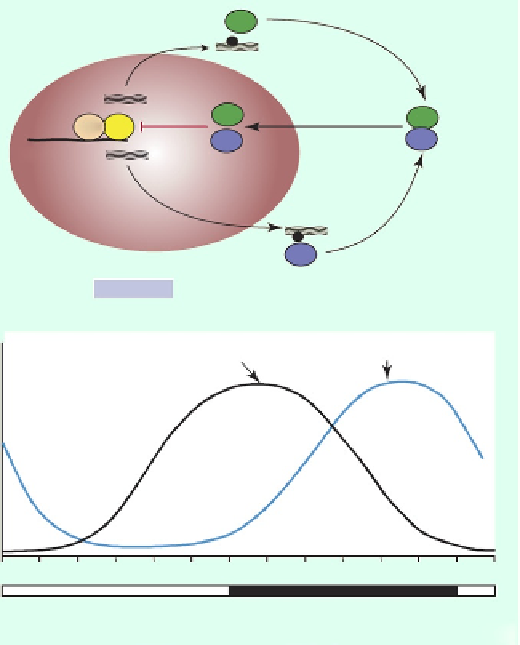Biology Reference
In-Depth Information
PER
PER
PER
TIM
CYC CLK
TIM
per/tim
Nucleus
TIM
Cytoplasm
per/tim mRNAs
PER/TIM proteins
0
2
4
6
8
10
12
14
16
18
20
22
24
26
Time of day
Current Biology
Figure 4.8
Overview of the
Drosophila
molecular circadian oscillator. Expression of the
per
and
tim
genes is promoted by the heterodimeric CLK-CYC transcription factors and reaches
a peak late in the day. Translation of
per
and
tim
RNAs leads to the gradual accumulation and
dimerization of PER and TIM proteins within the cytoplasm. The protein levels peak at night,
during which time they separately enter the nucleus to inhibit further CLK-CYC transcriptional
activity as shown.
Abbreviations
: CLK, clock; CYC, cycle; per, period; tim, timeless.
Source
: From
Nitabach and Taghert (2008).
in
Drosophila
, including photoreceptor neurons, which are exposed to daylight,
express
clk
and
cyc
? As a first impression, it seems paradoxal that
clk
and
cyc
genes
are expressed by clock neurons not directly exposed to the light, yet not expressed in
cells and neurons that are exposed. As it was explained earlier in this chapter, genes
do not understand nature's language; they have no hunch on what dawn and nightfall
presage for the fly's physiology, survival, and reproduction. To make these environ-
mental messages intelligible to genes, the messages must be translated into a lan-
guage the genes understand and the polyglot translator is in the brain.
The hierarchical character of the circadian mechanisms is clearer in mammals,
where the central neural clock controls and resets the peripheral clocks. The timing

Search WWH ::

Custom Search